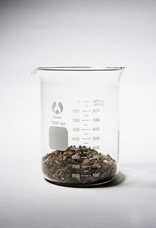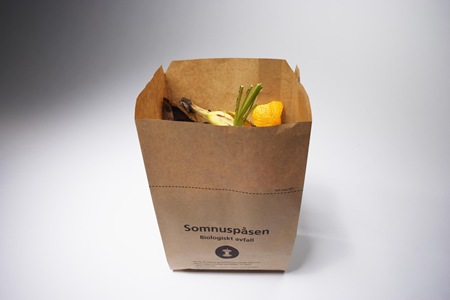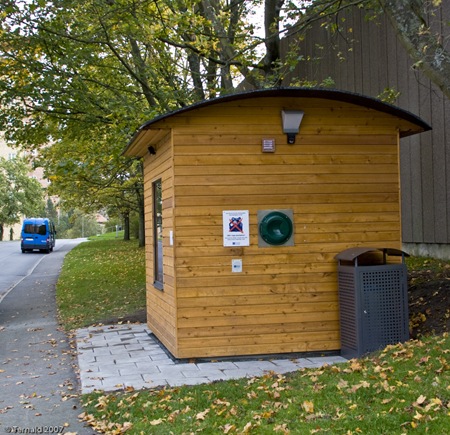1006 Morton Street
Baltimore, MD 21201
410.576.9131 | RW1haWw=
November 5 2007
Dry Food Waste - Somnus Method by Lars Smedlund
A Swedish inventor has developed a way to remove most of the water content from food waste. That is significant because food waste, the organic material thrown out of kitchens everyday, is typically composed of up to 75% water when it is put into the garbage. The water present in the organic material causes the waste to smell, makes it tough to handle and increases its weight significantly (1 gallon = ~8 lbs.). These extremely negative attributes of food waste make city or district food waste recycling programs challenging to initiate.
The system, named Somnus, is currently running in a one year pilot program. 180 residents of Sister Estrids Street in Guldheden, Gothenberg, are being asked to put their organic waste in paper bags and bring it to the Somnus unit (pictured below). On the user end the process is not significantly different from the way they dispose of waste currently. You see, many communities in Sweden already sort organic waste from inorganic trash. The organic waste is usually turned into biogas, incinerated, or made into agricultural composte. The only difference for the residents is that they put their food waste into a Somnus paper bag and bring it to the Somnus unit for disposal. The unit then chops the waste and uses a secret process of vented drying and bacterial additives to remove moisture present in the waste.
The Somnus unit uses about .75 kWh per month and that would serve nearly 200 families. It is in fact a very small number when compared to the energy costs of transporting untreated waste by truck to a processing facility.
 The results are impressive. The food waste becomes finely chopped dry odor free (relatively) material. The volume and weight of material needing to be transported is greatly reduced. Couple that with the fact that the waste can be retrieved twice per year instead of 52 times as is necessitated by the traditional organic collection system and the energy savings become remarkable. The dried food waste can be used directly in agricultural applications, burned or used in biogas. In addition, studies cited by the Smedlund Environmental Method Company claim that the dried material can actually produce 30% more biogas than wet waste.
The results are impressive. The food waste becomes finely chopped dry odor free (relatively) material. The volume and weight of material needing to be transported is greatly reduced. Couple that with the fact that the waste can be retrieved twice per year instead of 52 times as is necessitated by the traditional organic collection system and the energy savings become remarkable. The dried food waste can be used directly in agricultural applications, burned or used in biogas. In addition, studies cited by the Smedlund Environmental Method Company claim that the dried material can actually produce 30% more biogas than wet waste.
It remains to be seen whether or not this innovation will make a difference in adoption rates for biogas technology and food waste recycling. I am encouraged however by the appearance of such an innovation to what is an age-old process for preserving material. I have always believed that the most effective way to make our world more sustainable is not to invent entire new sciences, but just to make the technologies we already have more efficient.
For more information please visit the Smedlund Miljosystem website.
Recent Posts
Reimagining Harborplace to Create Space for Both Private Development and Expanded Public Space » Lawyer's Mall Reconstruction Progress » Confronting the Conventions of Customary Practice » Reconceived Facades: New Roles for Old Buildings » Ivy Bookshop Opens for Business! »
Categories
Yellow Balloon Baltimore » Products + Technology » Industry + Practice » Other » Architecture »
Links
Organizations
- USGBC Baltimore Regional Chapter »
- AIA - American Institute of Architects »
- USGBC »
- The Walters Art Museum »
- Green-e »
- Center for Building Performance and Diagnostics (CMU) »
- Green Globes »
- Prefab Lab (UT) »
- Center for Sustainable Development (UT) »
- Architecture 2030 »
- Bioneers »
- Street Films »
- FreeCycle »
- Chesapeake Bay Foundation »
- Archinect »
- BD Online - The Architects Website »
- National Wildlife Foundation »
- Natural Resources Defense Council »
- Overbrook Foundation »
- Merck Family Foundation »
- Ecology Center »
- New Building Institute »
- Neighborhood Design Center »
- The Leonardo Academy »
- ZigerSnead Architects LLP »
- The Rocky Mountain Institute »
- Urban Habitats »
- ACORE - American Council on Renewable Energy »
- Parks and People Foundation of Baltimore »
- Open Society Institute of Baltimore »
- Natural Capital Institute »
- Passive House US »
- Svanen Miljomark »
- Green Restaurant Association »
- Rocky Mountain Institute »
- Green Exhibits »
- Green Roundtable »
- John Elkington - SustainAbility »
- SustainAbility »
- Building America »
- Endangered Species Program - Fish and Wildlife Service »
- Congress for the New Urbanism »
- Urban Land Institute »
- Cool Roof Rating Council »
- Montgomery County (MD) Public Schools Green Building Program »
- National Institute of Standards and Technology Software »
- Scientific Certification Systems »
- Community Greens »
- CBECS »
- CASE - Center for Architecture Science and Ecology »
Interesting Sites
- The Ecologist »
- Treehugger »
- Grist »
- WIRED »
- Planet Architecture »
- MiljoBloggAktuellt - Environmental News Blog (Swedish »
- Sustainable Design Update »
- Eikongraphia »
- World Architecture News »
- The Cool Hunter »
- Design Center »
- ZEDfactory »
- Architen Landrell Associates Ltd. »
- Environmental Graffiti »
- businessGreen »
- Best Green Blogs Directory »
- Groovy Green »
- EcoGeek »
- Urban Ecology »
- Locus Architecture »
- Urbanite »
- A Daily Dose of Architecture »
- Adaptive Reuse »
- Audacious Ideas »
- Big Green Me »
- NOTCOT »
- Sustainable Baltimore »
- Thoughts on Global Warming »
- Green Maven »
- WorldChanging »
- Go For Change »
- Building Green »
- Home Energy Magazine »
- Home Energy Blog »
- FEMA Map Service- Federal Emergency Management Association »
- Architectural Graphic Standards »
- E-Wire »
- Post Carbon Cities »
- Alt Dot Energy »
- Whole Building Design Guide »
- B'more Green »
- EJP: Environmental Justice Partnership »
- Baltidome »
- OneOffMag »


